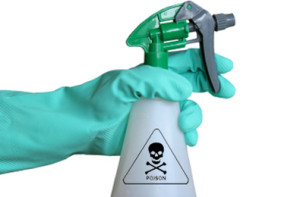Worse Than Dirt: Toxic Cleaning Products
 Although we buy cleaning products thinking they will protect us and kill all the nasty germs that lurk in our kitchen sinks and toilets, many of these home cleaning products are packing in a bigger punch that can have serious effects on our health and environment.
Although we buy cleaning products thinking they will protect us and kill all the nasty germs that lurk in our kitchen sinks and toilets, many of these home cleaning products are packing in a bigger punch that can have serious effects on our health and environment.
Take for example antibacterial hand soap that became so widespread after the H1N1 virus scare. Antibacterial hand soap was in every restaurant, school, and office space, ever since and became a normal commodity in American lives. Now the chemical found in antibacterial soaps called triclosan, has been banned in Minnesota for potentially promoting triclosan-adapted super bugs along with being no more effective, but more expensive than normal hand soap according to a study posted on the Oxford Journal.
Air fresheners use about 18.4 kWh of electricity and about half a gallon of oil every year while also containing higher levels of phthalates in some major air freshener brands that can cause birth defects. Many of these chemical ingredients are not listed on the label because they don’t have to be. Febreze alone has 87 chemicals, including BHT, which is a known neurotoxin, and acetaldehyde and propylene glycol, which are both carcinogens. Cleaning products aren’t required to include their ingredients on their label, which can be potentially dangerous when dealing with chemicals designed to kill bacteria, viruses and mold.
Bathroom and home cleaners are the worst as far as environmental and health risks. Brands as “family friendly” as Scrubbing Bubbles and Lysol have chemicals banned in the EU and statements on their label that say “harmful or fatal if swallowed” and can cause “irreversible damage to the eyes”. Environmental Working Group has a list of the top 10 worst bathroom and household cleaners to stay away from.
Having so many toxic cleaning products around the house is not worth it especially with animals or children exploring wherever they can fit their paws and fingers. There are alternative ways and products that can not only create a safer environment but also save you money like using the old fashioned white vinegar and water or various plants that have the power to remove 90% of chemicals in a room in under 24hrs. If you want something stronger there are plenty of organic, non-toxic cleaning chemicals that can make good replacements that can be found at ewg.org.